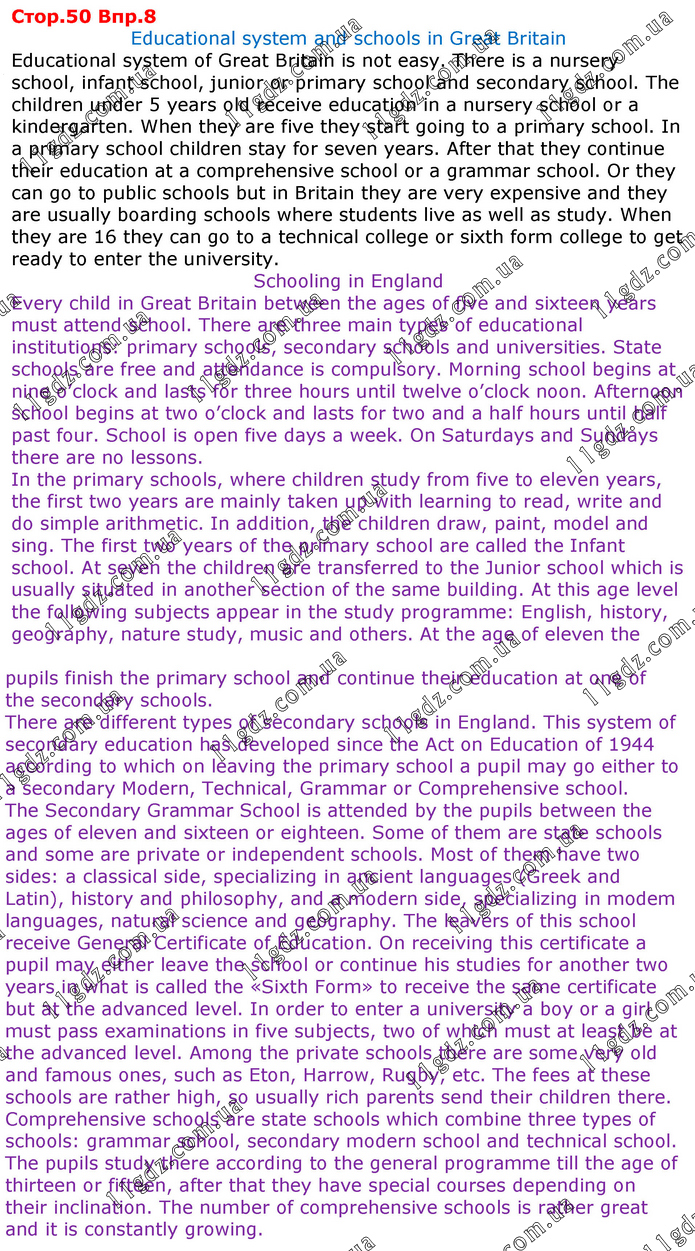Unit 2. School life » Стр.50 (8)

Educational system and schools in Great Britain Educational system of Great Britain is not easy. There is a nursery school, infant school, junior or primary school and secondary school. The children under 5 years old receive education in a nursery school or a kindergarten. When they are five they start going to a primary school. In a primary school children stay for seven years. After that they continue their education at a comprehensive school or a grammar school. Or they can go to public schools but in Britain they are very expensive and they are usually boarding schools where students live as well as study. When they are 16 they can go to a technical college or sixth form college to get ready to enter the university. Schooling in England Every child in Great Britain between the ages of five and sixteen years must attend school. There are three main types of educational institutions: primary schools, secondary schools and universities. State schools are free and attendance is compulsory. Morning school begins at nine o’clock and lasts for three hours until twelve o’clock noon. Afternoon school begins at two o’clock and lasts for two and a half hours until half past four. School is open five days a week. On Saturdays and Sundays there are no lessons. In the primary schools, where children study from five to eleven years, the first two years are mainly taken up with learning to read, write and do simple arithmetic. In addition, the children draw, paint, model and sing. The first two years of the primary school are called the Infant school. At seven the children are transferred to the Junior school which is usually situated in another section of the same building. At this age level the following subjects appear in the study programme: English, history, geography, nature study, music and others. At the age of eleven the pupils finish the primary school and continue their education at one of the secondary schools. There are different types of secondary schools in England. This system of secondary education has developed since the Act on Education of 1944 according to which on leaving the primary school a pupil may go either to a secondary Modern, Technical, Grammar or Comprehensive school. The Secondary Grammar School is attended by the pupils between the ages of eleven and sixteen or eighteen. Some of them are state schools and some are private or independent schools. Most of them have two sides: a classical side, specializing in ancient languages (Greek and Latin), history and philosophy, and a modern side, specializing in modem languages, natural science and geography. The leavers of this school receive General Certificate of Education. On receiving this certificate a pupil may either leave the school or continue his studies for another two years in what is called the «Sixth Form» to receive the same certificate but at the advanced level. In order to enter a university a boy or a girl must pass examinations in five subjects, two of which must at least be at the advanced level. Among the private schools there are some very old and famous ones, such as Eton, Harrow, Rugby, etc. The fees at these schools are rather high, so usually rich parents send their children there. Comprehensive schools are state schools which combine three types of schools: grammar school, secondary modern school and technical school. The pupils study there according to the general programme till the age of thirteen or fifteen, after that they have special courses depending on their inclination. The number of comprehensive schools is rather great and it is constantly growing.